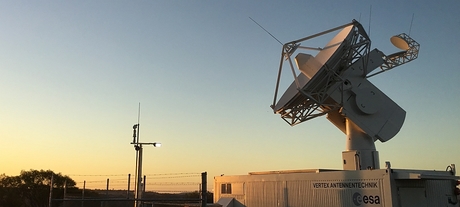New space tracker begins work in WA

Europe’s tracking station in Perth has closed, but its New Norcia station has been expanded.
The European Space Agency (ESA) has commissioned a new tracking dish in Western Australia. The antenna — which is located at ESA’s ground station at New Norcia, 140 kilometres north of Perth — will be used for communicating with launch vehicles and newly launched satellites, taking advantage of the site’s location under the flight paths of launchers departing from Europe’s spaceport in Kourou, French Guiana.
Since 2002, ESA has also operated a much larger 35-metre-diameter deep space tracking antenna at New Norcia. Its size and technology are not ideal, however, for communicating with rockets or satellites that are just entering orbit and still very close to Earth.
In contrast, the new dish, just 4.5 metres across, will quickly and precisely lock onto and track satellites during their critical first orbits, up to roughly 100,000 kilometres out, as well as launch vehicles such as Europe’s Ariane 5, Vega and Soyuz.
It can also ‘slave’ the larger dish, which can then be accurately pointed to receive tracking information and telemetry at higher rates than the small dish.
The overall effort to design, build and install the antenna, provide the infrastructure and upgrade the existing station was valued at €6 million.

“We are delighted to inaugurate ESA’s new antenna at New Norcia, where we have benefited for over a decade from both the hospitality and support of the local community as well as the expertise of Australian industrial partners,” said ESA’s Juan Miró.
“The new antenna is another link in the decades-long cooperation between Europe and Australia for space exploration, science, engineering and technology development.”
In the coming years, the new antenna will track launches from Kourou, as well as high-profile missions such as Galileo navigation satellites, the BepiColombo probe to Mercury and ExoMars going to the Red Planet. It has already proven its technical fitness for operational service, having been used to track the LISA Pathfinder spacecraft in December 2015.
Both New Norcia antennas are part of Estrack, ESA’s global network of ground stations in seven countries that provide the link between satellites in orbit and flight control teams at ESA’s mission control centre in Darmstadt, Germany.
Old antenna retired
Development and construction of the new antenna was prompted by the need to relocate the tracking capability that, until the end of 2015, had been provided by another ESA station in Perth. The Perth antenna was decommissioned in December 2015 after 30 years of operation.
“With the closing of Perth station, ESA would have lost its capability to support newly launched satellites from Western Australia, which is a critical location for most European missions,” said Manfred Lugert, head of ESA’s Ground Facilities Operations Division.
Ironically, the retirement of the antenna came about not due to any technical obsolescence, but rather through a very human factor— Perth’s expanding population and the conflicting needs for radio spectrum.
The ever-growing metropolitan area of Perth is encroaching on the station’s compound, the Perth International Telecommunications Centre, making it increasingly difficult to ensure an interference-free environment for the most-used frequencies.

The growing demand of Perth’s citizens and businesses for wireless internet access, and in particular the needs of outside TV broadcasting, led the ACMA to withdraw permission for the use of certain frequencies by the Perth station as of 31 December 2015.
“[The] Perth antenna retirement provides an opportunity to consolidate ESA’s Australian tracking facilities at our existing New Norcia station… while deepening our partnership with local Australian telecommunication companies, all of which have strong technological expertise that we can tap,” said Lugert.
The decommissioned Perth antenna’s routine tracking and telecommanding will be largely taken over by commercial service providers, including SSC Australia, which operates the Western Australia Space Centre near Dongara, 400 kilometres north of Perth.
GNSS technique helps pedestrians navigate 'urban canyons'
The technique addresses the shortcomings of traditional GNSS systems in complex urban landscapes...
LEO and UWB hold the key to interference-free navigation
While advanced positioning technologies are crucial for overcoming challenges in navigation, many...
Ericsson provides 5G for high-stakes race
Ericsson has come on board as a team partner for the ultrahigh-tech catamaran race SailGP,...





